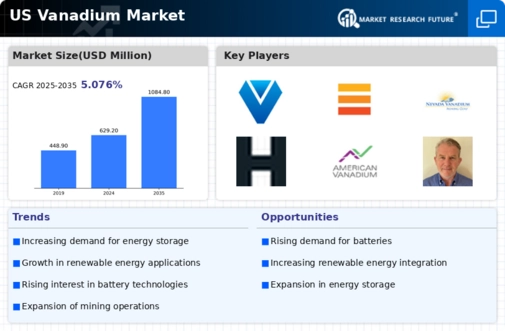The vanadium market is currently characterized by a dynamic competitive landscape, driven by increasing demand for high-performance alloys and energy storage solutions. Key players are actively pursuing strategies that emphasize innovation, sustainability, and regional expansion. For instance, Largo Resources Ltd (CA) has positioned itself as a leader in sustainable vanadium production, focusing on environmentally friendly extraction methods. Similarly, American Vanadium Corp (CA) is concentrating on developing advanced vanadium redox flow batteries, which are gaining traction in the renewable energy sector. These strategic focuses not only enhance their market presence but also contribute to a competitive environment that prioritizes technological advancement and sustainability.
In terms of business tactics, companies are increasingly localizing manufacturing and optimizing supply chains to enhance efficiency and reduce costs. The market structure appears moderately fragmented, with several players vying for market share. However, the collective influence of major companies like Largo Resources Ltd (CA) and American Vanadium Corp (CA) is significant, as they set benchmarks for operational excellence and innovation within the industry.
In November 2025, Largo Resources Ltd (CA) announced a strategic partnership with a leading battery manufacturer to develop next-generation energy storage solutions. This collaboration is expected to leverage Largo's sustainable vanadium production capabilities, potentially positioning the company at the forefront of the energy transition. The strategic importance of this partnership lies in its potential to enhance Largo's product offerings and expand its market reach in the rapidly growing energy storage sector.
In October 2025, American Vanadium Corp (CA) launched a new line of vanadium redox flow batteries aimed at commercial applications. This initiative reflects the company's commitment to innovation and addresses the increasing demand for reliable energy storage solutions. The introduction of this product line is likely to strengthen American Vanadium's competitive position, as it aligns with the broader trend towards renewable energy adoption and sustainability.
In September 2025, Bushveld Minerals Limited (GB) completed a significant expansion of its vanadium production facility in South Africa, which is expected to enhance its supply capabilities to the US market. This expansion not only increases production capacity but also underscores Bushveld's strategic focus on meeting the growing demand for vanadium in various applications, including steel manufacturing and energy storage. The implications of this expansion are profound, as it may lead to improved supply chain reliability and cost efficiencies.
As of December 2025, the competitive trends in the vanadium market are increasingly defined by digitalization, sustainability, and the integration of advanced technologies such as AI. Strategic alliances are becoming more prevalent, as companies recognize the need to collaborate to enhance innovation and operational efficiency. Looking ahead, competitive differentiation is likely to evolve from traditional price-based competition to a focus on technological innovation, supply chain reliability, and sustainable practices. This shift indicates a transformative phase in the market, where companies that prioritize these aspects may gain a significant competitive edge.


















Leave a Comment